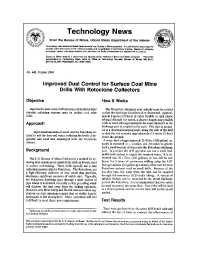Mining Publication: Technology News 440 - Improved Dust Control for Surface Coal Mine Drills With Rotoclone Collectors
Original creation date: October 1994
The U.S. Bureau of Mines field tested a method for reducing dust emissions on small drills, such as Davey, used in surface coal mining. These drills typically use a dust collection system called a Rotoclone. The Rotoclone, not a high-efficiency collector of very small dust particles, discharges significant amounts of visible dust. Typically, the Rotoclone discharge goes through a short section of pipe where it is directed vertically so that prevailing winds will disperse the dust away from the drilling operation. However, new Mine Safety and Health Administration regulations on dust emissions require that no visible dust be discharged to the atmosphere. Many operations will find it difficult to meet these new requirements.
Authors: Bureau of Mines
Technology News - October 1994
NIOSHTIC2 Number: 20023940
U.S. Department of the Interior, Bureau of Mines, Technology News 440, 1994 Oct :1-2
See Also
- Analysis of Mine Fires for All U.S. Underground and Surface Coal Mining Categories: 1990-1999
- Best Practices for Dust Control in Coal Mining
- Evaluation of the Approach to Respirable Quartz Exposure Control in U.S. Coal Mines
- Field Evaluation of Air-blocking Shelf for Dust Control on Blasthole Drills
- Implementation of an Ergonomics Process at a US Surface Coal Mine
- Improved Drill Shroud Capture of Respirable Dust Utilizing Air Nozzles Underneath the Drill Deck
- NIOSH Hazard Controls 27 - New Shroud Design Controls Silica Dust from Surface Mine and Construction Blast Hole Drills
- Safety and Health Regulatory Changes and Technology Developments in U.S. Coal Mining
- Technology News 447 - Dust Collector Discharge Shroud Reduces Dust Exposure to Drill Operators at Surface Coal Mines
- Underground Coal Mining Disasters and Fatalities: United States, 1900-2006
- Content source: National Institute for Occupational Safety and Health, Mining Program


 ShareCompartir
ShareCompartir
